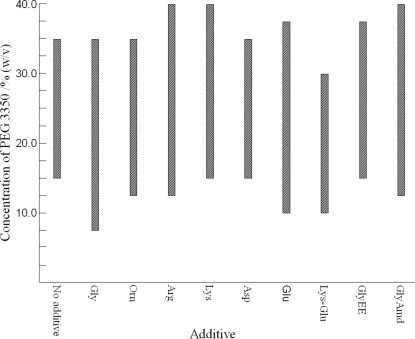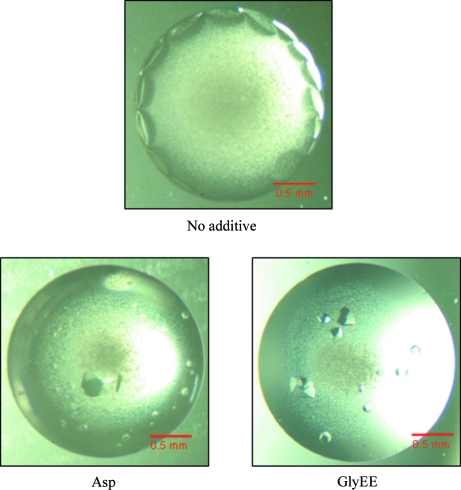The effect of the addition of amino acids and amino acid derivatives on the crystallization of hemoglobin and ribonuclease A has been evaluated. The results showed that certain types of additives expand the concentration conditions in which crystals are formed.
Keywords: protein crystallization, promotion of crystallization, additives, amino acids, amino acid derivatives, protein aggregation
Abstract
Determination of the appropriate conditions for protein crystallization remains a highly empirical process. Preventing protein aggregation is necessary for the formation of single crystals under aggregation-prone solution conditions. Because many amino acids and amino acid derivatives offer a unique combination of solubility and stabilizing properties, they open new avenues into the field of protein aggregation research. The use of amino acids and amino acid derivatives can potentially influence processes such as heat treatment and refolding reactions. The effect of the addition of several amino acids, such as lysine, and several amino acid derivatives, such as glycine ethyl ester and glycine amide, on the crystallization of equine hemoglobin and bovine pancreatic ribonuclease A has been examined. The addition of these amino acids and amino acid derivatives expanded the range of precipitant concentration in which crystals formed without aggregation. The addition of such additives appears to promote the crystallization of proteins.
1. Introduction
Protein crystallography is of increasing importance for biological research. The rapid determination of protein structures has been achieved by progress in areas such as genetics, purification techniques, detector technology and synchrotron radiation. Crystallography requires single crystals of high quality; however, an efficient method of obtaining these crystals has been difficult to determine. This difficulty depends on a huge number of parameters that influence protein crystallization, which include protein concentration, pH, ionic strength, type and concentration of precipitant, and the additives in the crystallization solution (McPherson, 1999 ▶).
During crystallization, proteins often aggregate and do not crystallize. Various studies by dynamic light scattering have shown that crystal nucleation is generally characterized by a relatively sharp transition from a monodisperse solution to insolubility with increasing precipitant concentration, whereas a continuum of aggregates before precipitation leads to the formation of a predominantly amorphous material (Mikol et al., 1990 ▶). Therefore, the prevention of nonspecific protein aggregation plays a key role in the formation of nuclei and/or single crystals under aggregation-prone solution conditions. In some cases, aggregation can be eliminated by imposing a reasonably high ionic strength to disrupt the electrostatic interactions that cause some molecules to aggregate. Guanidine and urea are well known aggregation suppressors that minimize the hydrophobic intermolecular interaction between proteins. These denaturants increase the solubility of unfolded protein molecules (Buchner & Rudolph, 1991 ▶; Rudolph & Lilie, 1996 ▶). They are often used as additives for the initial screening, but can decrease the stability of the native state of proteins.
Recently, amino acids, such as arginine, and amino acid derivatives, such as glycine ethyl ester (GlyEE), which are non-denaturating reagents, have been widely used in biochemical studies to increase refolding yields by decreasing aggregation and to increase protein stability (Shiraki et al., 2002 ▶, 2004 ▶, 2005 ▶; Arakawa & Tsumoto, 2003 ▶; Taneja & Ahmad, 1994 ▶; Sakamoto et al., 2004 ▶). It is also expected that these non-denaturating reagents will suppress nonspecific aggregation in supersaturated protein solutions during the crystallization process. We have observed the beneficial effect of the addition of these reagents on the crystallization of hen egg-white lysozyme (in preparation). The results showed that the additives expanded the crystallization conditions, such as protein concentration, the types of precipitant and the precipitant concentration. In the study reported here, we investigated the effect of the addition of amino acids and amino acid derivatives on the crystallization of two new proteins: equine hemoglobin and bovine pancreatic ribonuclease A. As in the lysozyme study, crystals of both proteins readily formed in an expanded concentration range of known precipitants. The results suggest that the addition of these reagents is generally effective in promoting the crystallization of many types of proteins.
2. Materials and methods
2.1. Reagents
l-Lysine/HCl, GlyEE/HCl and aspartic acid/NaOH were purchased from Sigma–Aldrich Co. (St Louis, MO, USA). The other amino acids, amino acid derivatives and other chemicals were purchased from Wako Pure Chemical Industries (Osaka, Japan). All chemicals used were of high-quality analytical grade. Equine hemoglobin was purchased from Sigma–Aldrich Co. Bovine pancreatic ribonuclease A was purchased from Worthington Biochemical Co. (California, USA). All proteins were used without further purification. Hemoglobin and ribonuclease A were crystallized with PEG 3350 (McPherson, 1999 ▶) and with ammonium sulfate (Chatani et al., 2002 ▶) as a precipitant, respectively.
2.2. Characterization of the effects for crystallization
We prepared solutions containing 40 mg ml−1 of hemoglobin in 0.1 M sodium phosphate at pH 6.5, and 28.4 mg ml−1 ribonuclease A in 0.1 M sodium acetate at pH 6.0. All protein solutions were centrifuged at 15000g for 20 min at 293 K. For hemoglobin crystallization, we prepared a reservoir solution containing 5.0–40.0% (approximately saturated solution) PEG 3350 at 2.5% intervals, 0.2 M additives and 0.1 M sodium phosphate (pH 6.5). For ribonuclease A crystallization, we prepared a reservoir solution containing 35% ammonium sulfate, 0.5 M additives and 0.1 M sodium acetate (pH 6.0). The hanging-drop vapor-diffusion method was used for crystallization at 293 K. Hanging droplets were made by mixing 1 µl of protein solution with 1 µl of reservoir solution containing additives. Thus, the initial concentration of the additives in each hanging droplet was 0.1 and 0.25 M, respectively. The volume of reservoir solution was 500 µl for each setting. In all the crystallization experiments, reproducibility was evaluated by repeating each experiment more than three times.
3. Results and discussion
Fig. 1 ▶ shows the results of crystallization of hemoglobin in the presence of additives with an initial concentration of 0.1 M in the hanging droplet at pH 6.5. The control experiment showed that hemoglobin crystals were obtained in the range 15.0–35.0%(w/v) of PEG 3350 in the absence of additives. In contrast, the concentration conditions of precipitant expanded in many cases in the presence of the additives. The use of Glu, Arg and glycine amide (GlyAmd) as additives was most effective for the expansion of the conditions of the precipitant concentration. When the concentration exceeded the precipitant by more than 37.5%, the hemoglobin solution aggregated in the absence of any additives, whereas single crystals appeared in the presence of Lys, Arg and GlyAmd, even at 40% of PEG 3350. In the presence of Gly, Glu and Lys–Glu, the concentration range in which crystals were obtained was expanded to a lower concentration. All the crystals had similar morphologies. In addition, the crystals formed more rapidly in the presence of the additives.
Figure 1.
Concentration range of precipitant in the reservoir solution in the presence of additives in which hemoglobin crystals were formed. Hanging droplets were made by mixing 1 µl of 40 mg ml−1 hemoglobin solution with 1 µl of reservoir solution. The reservoir solutions contain 5.0–40.0% PEG 3350 at 2.5% intervals, 0.2 M additives and 0.1 M sodium phosphate (pH 6.5). The bars show the precipitant concentration range in which crystals were formed.
For ribonuclease A, no crystals formed and aggregations occurred under all concentration conditions of the precipitant in the absence of additives (Fig. 2 ▶), even though previously reported crystallization conditions were used. Difficulties associated with the crystallization could have been attributable to the different properties of each protein depending on the preparation and the commercial sample batch. In this experiment, ribonuclease A crystals were grown only from the conditions containing 0.25 M Asp or GlyEE (Fig. 2 ▶) in the droplet, suggesting that the presence of an appropriate additive suppresses the nonspecific aggregation and raises the probability of obtaining crystals.
Figure 2.
Results of the crystallization of ribonuclease A with and without the addition of Asp and GlyEE. Hanging droplets were made by mixing 1 µl of 28.4 mg ml−1 ribonuclease A solution with 1 µl of reservoir solution. The reservoir solutions contain 35% ammonium sulfate, 0.5 M additives and 0.1 M sodium acetate (pH 6.0).
The presence of an amino acid or an amino acid derivative suppresses aggregation by hydrophobic interaction between denatured proteins. In a supersaturated solution of proteins in their native state and precipitant, it is considered that this should control hydrophobic interactions between the protein surfaces and suppress nonspecific aggregation. Additionally, the additives shield charges of the various functional groups on the protein surface and weaken the interaction between charged amino acid residues (Arakawa et al., 2007 ▶). This should also make it possible to precipitate gently under high-concentration crystallization conditions. Amidation and esterification of the carboxyl group in Gly change the electrostatic character and the hydrophobicity of the amino acid and change the ability to form hydrophobic and electrostatic interactions. Choosing the appropriate additives is necessary for controlling hydrophobic and electrostatic interaction between protein molecules.
Spontaneous nucleation of protein crystals generally occurs in a highly supersaturated solution and the nuclei cannot be generated in a less supersaturated solution. However, our results using hemoglobin showed that many crystals appeared in a less supersaturated solution condition in the presence of an amino acid or an amino acid derivative. These results suggest that these additives decrease the solubility of hemoglobin and act as a precipitant. It is interesting that Glu, Arg and GlyAmd expand the conditions for both lower and higher concentrations, and they suppress nonspecific precipitation while promoting ordered precipitation.
4. Conclusion
We examined the effect of various additives on protein crystallization for two proteins. We found that some amino acids and amino acid derivatives generally promote protein crystallization. Further studies should address the mechanism of crystallization in the presence of such additives and optimize conditions to apply this method more generally and specifically on protein crystallization. Creating ordered crystallization of proteins should be more easily achieved in the future by choosing an additive based on the properties of the protein.
Acknowledgments
We appreciate Dr Hiroshi Komatsu for useful discussions. We thank Ms Satomi Uramoto for performing many of the crystallization experiments.
References
- Arakawa, T., Ejima, D., Tsumoto, K., Obeyama, N., Tanaka, Y., Kita, Y. & Timasheff, S. N. (2007). Biophys. Chem.127, 1–8. [DOI] [PubMed]
- Arakawa, T. & Tsumoto, K. (2003). Biochem. Biophys. Res. Commun.304, 148–152. [DOI] [PubMed]
- Buchner, J. & Rudolph, R. (1991). Biotechnology, 9, 157. [DOI] [PubMed]
- Chatani, E., Hayashi, R., Moriyama, H. & Ueki, T. (2002). Protein Sci.11, 72–81. [DOI] [PMC free article] [PubMed]
- McPherson, A. (1999). Crystallization of Biological Macromolecules. New York: Cold Spring Harbor Laboratory Press.
- Mikol, V., Hirsch, E. & Giege, R. (1990). J. Mol. Biol.213, 187–195. [DOI] [PubMed]
- Rudolph, R. & Lilie, H. (1996). FASEB J.10, 49–56. [PubMed]
- Sakamoto, R., Nishikori, S. & Shiraki, K. (2004). Biotechnol. Prog.20, 1128–1133. [DOI] [PubMed]
- Shiraki, K., Kudou, M., Fujiwara, S., Imanaka, T. & Takagi, M. (2002). J. Biochem (Tokyo), 132, 591–595. [DOI] [PubMed]
- Shiraki, K., Kudou, M., Nishikori, S., Kitagawa, H., Imanaka, T. & Takagi, M. (2004). Eur. J. Biochem.271, 3242–3247. [DOI] [PubMed]
- Shiraki, K., Kudou, M., Sakamoto, R., Yanagihara, I. & Takagi, M. (2005). Biotechnol. Prog.21, 640–643. [DOI] [PubMed]
- Taneja, S. & Ahmad, F. (1994). Biochem. J.303, 147–153. [DOI] [PMC free article] [PubMed]




